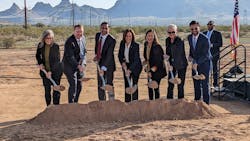Ten West Link Transmission Line Construction Kicks Off
Project partners joined by Vice President Kamala Harris commemorated the start of construction for a new 125-mile, 500-kilovolt high-voltage transmission line that will enable more use of renewable energy across the Southwest and Southern California.
Ten West Link is being developed by DCR Transmission, LLC., a joint venture led by affiliates of Lotus Infrastructure Partners. The power line will connect to the Arizona power grid just west of Tonopah, near the Delaney Substation. The other end connects to a substation at Blythe, California.
According to project partners, the construction will bring more than 350 jobs to the region, including more than 250 union construction jobs at peak. It is expected to come online by the end of 2023.
When completed, this transmission line will have the initial capacity to transmit 3,200 MW between central Arizona and Southern California, improving the reliability of the bulk power system serving the two regions. Additionally, Ten West Link will facilitate development of new renewable energy solar and solar plus storage resources in the Southwest.
The transmission project uses the U.S. Department of Energy’s Energy Corridor and U.S. Bureau of Land Management’s-designated utility corridors. The proposed path of the project avoids the Kofa National Wildlife Refuge and major population centers.
Ten West Link will be under the operational control of the CAISO, with more than 7,000 MW of renewable energy resources currently applying to interconnect to the bulk transmission grid via the line.
DCRT was chosen to develop the energy project by the California Independent System Operator Corporation following solicitation in 2015. The capacity of Ten West Link will become part of the grid, managed by the CAISO.
The U.S. Department of the Interior approved the project’s construction in July 2022, after determining it would lower costs for customers.
The Ten West Link Transmission Line is an infrastructure project covered under Title 41 of the FAST Act (FAST-41). Through the Federal Permitting Improvement Steering Council, the BLM coordinated reviews with other agencies, including the National Park Service, U.S. Fish and Wildlife Service, Advisory Council on Historic Preservation, Council on Environmental Quality, Department of Defense, as well as Tribal leadership and local communities, to make a timely and informed project decision.
About the Author
Jeff Postelwait
Managing Editor
Jeff Postelwait is a writer and editor with a background in newspapers and online editing who has been writing about the electric utility industry since 2008. Jeff is senior editor for T&D World magazine and sits on the advisory board of the T&D World Conference and Exhibition. Utility Products, Power Engineering, Powergrid International and Electric Light & Power are some of the other publications in which Jeff's work has been featured. Jeff received his degree in journalism news editing from Oklahoma State University and currently operates out of Oregon.
